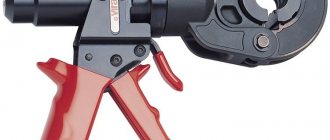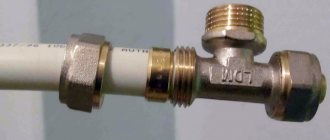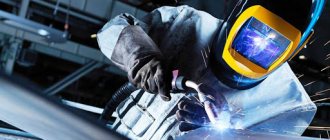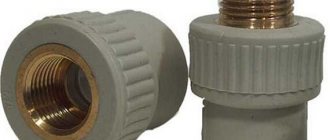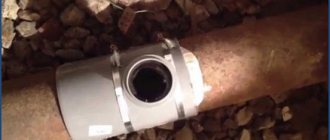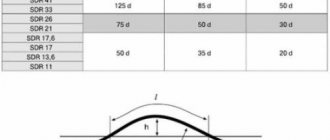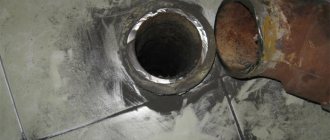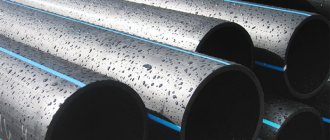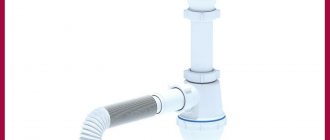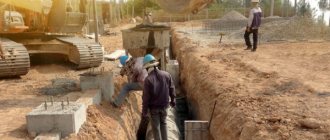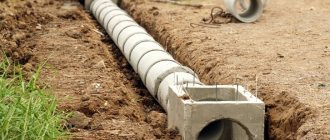Technology of welding cast iron with steel using consumable electrodes
Before starting any type of welding work, you need to prepare the metals to be joined. Their surfaces in the joint area must be cleaned to a characteristic metallic shine. Cast iron is a porous metal, so oily liquids can penetrate its body quite easily and deeply. Therefore, areas where greasy stains are found must be cleaned until they completely disappear. The welding mode itself depends entirely on the selected equipment.
- Welding steel to cast iron with a unit no-load voltage of more than 54 V is possible only when using alternating current.
- When the no-load voltage of the unit is less than 54 V (for many models of welding equipment this is a standard value), welding work is performed with direct current having reverse polarity.
Cast iron and steel parts in both situations are heated to 600 degrees to prevent them from expanding during the welding process.
It is important to understand! The more a metal expands, the more it contracts after cooling. If the above requirements are met, the seam joint will be of high quality with just one pass of the electrode over it.
What electrodes should be used to cook steel with cast iron?
Previously, on the site about MMA welding, we already talked about electrodes for cast iron and how to make them with your own hands. As for electrodes for welding cast iron with steel, the following brands of electrodes have shown the greatest efficiency in this matter:
TsCh-4 electrodes are used to achieve excellent results when welding steel with cast iron, both using hot and cold technologies. Welding with TsCh-4 electrodes is carried out using direct current with reverse polarity, and, as a rule, only in the lower position.
OZCH-2 electrodes show themselves to be quite effective when welding thin metals.
MNCh-2 electrodes are a specialized brand of electrodes that give decent results when welding cast iron with steel.
Imported electrodes for welding steel and cast iron are also very popular among our craftsmen. First of all, these are electrodes for cast iron Ficast NiFe , electrodes Zeller 855 and 866 .
Welding of thick-walled samples with alloy additives
To weld cast iron and steel, when their structure contains alloyed additives or the samples being joined have a sufficiently large cross-section, the following points must be taken into account.
- The parts are not preheated.
- The connection of two different metals is carried out using small rollers up to 2.5 mm long.
- The second roller is formed after the first one has completely cooled.
The tightness of the seam joint depends precisely on the two extreme points. When using this welding technique, there is no need to talk about the tightness of the connection between steel and cast iron, since each subsequent bead is placed on the previous bead, which is completely cold. In this case, the resulting seam will be quite fragile.
Electrodes for cast iron
For RDS (MMA) the following are used:
• cast iron is now rare. They can be very large in diameter from 6 to 15 mm. It is recommended to use electrodes with a minimum diameter and at low currents. • copper based, • nickel based, • steel.
Application of steel electrodes
For cast iron, you can't imagine anything worse. It is advisable if minor defects are being repaired and no further machining is planned. The bleaching process causes the seam to become pliable and brittle. TsCh-4 electrodes are used, the rod of which is made of pure Fe or UONII-13/45, which are used for welding “black” and low-alloy steels
The best characteristics are shown by nickel-based electrodes (ESAB electrodes OK 92.18, OK 92.58). They carry out cold welding of cast iron (see below), but slight heating to 40 degrees is recommended. The resulting seam has good strength characteristics and can be processed with a cutter or milling cutter without restrictions.
Cast iron is welded well with copper-based electrodes, but you will not get the strength properties of the weld and heat-affected zone, this is due to the fact that Cu and Fe do not interact with each other until the Cu dissolves.
For semi-automatic welding
steel, nickel and silicon-bronze wires are used in combination with shielding gas or its mixtures.
Distinguish between hot and cold welding
• During hot welding, cast iron is heated to a temperature of 250 to 650 degrees, followed by melting at low currents. Overheating and high currents can lead to cracking. After the welding operation, the cast iron is slowly cooled. To do this, it can be placed in sand or covered with thermal insulation material.
• Cold welding for cast iron is carried out without heating, but you need to make the seams as short as possible, it is necessary that they cool gradually.
Read Repair of cast iron products by welding. From the experience of Uralmashplant.
Makita anti-splash sander
The welder may encounter “plenty” of spatter. In this case, stripping to a depth of more than 0.5 mm should help. The fact is that in the manufacture of the sand-clay mold into which cast iron is cast, not only sand and clay are used, but also binding components, including rosin. When heated, these impurities may enter the surface layer, and they “gas” when heated. Use a Makita sander with a sanding or roughing wheel to remove the surface layer.
Some technical points of the welding procedure
- For this option of joining different metals, the selection of welding parameters and materials is carried out based on the limitations of the weldability of cast iron. If there are no special strength requirements for the weld, only nickel filler materials are used.
- Welding processes with increased specific heat input and the formation of a significant weld pool are not recommended.
- A number of cast irons, which contain a large amount of carbon, are considered non-weldable due to their tendency to form cracks.
- Cast iron and steel structural elements can be welded together directly using a nickel filler material made specifically for joining cast irons. But if critical deformation of the material occurs and significant loads occur, this will not be enough. In such situations, before welding a steel element to a cast iron product, it is recommended to fuse a nickel filler material on the surface of the cast iron part.
- Welding cast iron with steel can be done without preheating the metal, but only if the part will subsequently operate at temperature conditions greater than 300 degrees. In this case, small-sized products being welded are subject to general heating; when connecting large parts, only the welding zone is heated.
- The coefficient of linear expansion of cast iron is quite low, and this metal is also characterized by low ductility. Therefore, the shrinkage stress that occurs in the connection must be reduced. To do this, immediately after completion of welding it is necessary to forge the seam.
- A high-quality connection result can be achieved if small cross-section electrodes are used for welding, and surfacing is performed with short beads (no more than 5 cm) in the transverse direction. For this purpose, it is necessary to tilt the welding arc onto the previous roller, but not in the direction of the base metal.
Practice shows that all technologies for joining steel and cast iron developed to date are quite effective, but only if the welding mode and consumables are selected correctly.
Argon arc welding
In principle, what was said above fully applies to argon arc welding with a non-consumable electrode in a shielding gas environment. The only thing added to welding technology is additive and gas. Everything is clear with gas, because it is the same for all types of welding, regardless of the type and type of workpieces being joined, or rather, their metals.
But the filler material is selected according to the properties of the base metal being welded. And since there are two of them, you will have to take into account the welding abilities of each of the two. And since cast iron is, so to speak, weak, then the additive should be selected according to it. So, as a filler material, you can use welding flux-cored wire, from which the coating is beaten off. Some craftsmen use strips of cast iron, cut into small pieces.
True, both materials can be used only if the welder has enough experience in using this technology. The thing is that an incorrectly set mode and an incorrect melting speed of the additive can lead to the formation of so-called intermetallic structures in the weld pool. They have increased fragility. This is why practical experience is considered an important component of the quality of the final result when welding steel and cast iron with a non-consumable tungsten electrode.
Therefore, some purely practical advice.
- To weld two metals, it is best to use nickel-based additives, which were specifically invented for welding cast iron products. But if the requirements for the strength and reliability of the joint are quite large, then even such an additive will not be able to fulfill them.
- You cannot cook cast iron with steel with a wide bath and large heat inputs.
- It is recommended to deposit a nickel additive on the cast iron edge before starting welding work. That is, to form the so-called transition layer.
- You can weld cast iron to steel without preheating or with it. The first option is chosen only if during operation of the welded part it will not be subjected to great heat, no more than +300C. If there are no such requirements, then heating will have to be done. Small workpieces are heated completely, large ones only in the welding zone.
- Cast iron is a metal with low ductility and very low linear expansion compared to steel. Therefore, it is very important to reduce shrinkage stresses in the weld. Cast iron shrinks a little, steel, on the contrary, shrinks a lot.
What can you do about the last position? The greatest effect can be achieved by hitting the weld with a hammer. This process is called forging. For this, a hammer with a rounded head is used. The metal must be beaten to such an extent that a ringing sound is produced.
There is another option to increase the effect. To do this, you will have to weld with a large diameter filler wire. The seam itself must be done using rollers 4-5 cm long each. In this case, the electric arc should be directed towards the previous roller. It is necessary to cook evenly along the joint without oscillatory movements.
Quality check and connection types
The method and type of connection of cast iron pipes depends on the category of the selected material, but even taking this into account, it is necessary to carefully monitor the quality so that problems do not arise in the future. It is necessary to contact a manufacturer that produces quality products, for example, Smart SML. Key points to pay attention to:
- the outside of the pipes must be clean and smooth - no stains, bumps or dents;
- the entire surface must be flat and not allow any deformation;
- the structure of the material must be fine-grained and necessarily uniform, which can be seen in the cut;
- the walls of the pipe must be the same in thickness - this can be checked by tapping, as a result of which the sound will be clear and uniform in any place.
There are several ways to connect cast iron pipes , which are widely used using modern technologies. Among them are:
- connecting socket pipes using a rubber gasket;
- using a coupling;
- saddle - connects the main pipeline and the secondary one, the diameter should be from 80 to 600 mm.
The principle of connecting cast iron sewer pipes depends on several factors, including the materials used, technical requirements for the pipeline, the location of the main network and much more. If these points are not taken into account, significant damage to the plumbing system is possible. The types of connections of cast iron pipes affect the principle of sealing the water supply at the joints.
Pipe connection
Cast iron pipes are connected very simply. The main part of the other pipe is inserted into the socket of one pipe. To increase the tightness and reliability of the connection, it is sealed with a cap. By heel we mean a cord made of organic fiber (usually linseed) soaked in a mixture of oils.
However, such a connection does not ensure reliable fastening; displacement of the pipes is not excluded. And when water passes under high pressure, it is possible that the seal may be squeezed out. Therefore, the free space of the socket is filled with cement mortar, molten lead or molten sulfur compounds.
If you need to create a connection of complex shape, then crosses, tees and adapters are used. When installing shut-off valves, flanges with paronite gaskets are used for connection.
Most often, cast iron pipes are used to supply cold water to houses. They are no longer used indoors.
Pipes are laid to a considerable depth. At the same time, they can be laid directly into the ground, without the use of protective reinforced concrete channels.
The flow of water under high pressure and soil movements sometimes lead to divergence of pipe joints.
Cast iron water pipes are also used for sewerage installations. And in this case they serve more reliably, since there is no high pressure in the system.
The connections do not come apart, and the system lasts a long time, requiring virtually no repairs.
Installation features
To ensure a reliable connection between a cast iron water supply and a plastic one during partial replacement, use one of the following methods:
- A rubber gasket is used if the socket has been kept in good condition and prepared for connection.
- Plastic adapter with rubber seal. If the bell had to be cut off for a number of reasons (severe deformation or damage), this method is used.
- A press fitting is a special connector equipped with a socket for a plastic pipe and a thread for a cast iron part of the water supply.
- Embossing with linen winding. Before the advent of silicone sealants, this method was used most often; it is still used with cast iron water pipes.
- Silicone sealant. If the joint between the plastic and cast iron pipes does not exceed 2 mm, it is possible to use sealing with plumbing silicone.
- Flange connection. Used with additional components and welding equipment.
It is important to pay attention to the process of securing the pipes. There are two ways - moving and stationary. A fixed fastener rigidly fixes the pipe, but if there is a temperature effect that leads to contraction at the points of contact with the fasteners, a suspension is preferred.
Installation of cast iron coupling
Since cast iron pipes can also be connected using special couplings, it is necessary to carefully consider the installation process. It includes the following steps:
- To apply the sealant around the entire circumference of the coupling and pipe, it is necessary to ensure free access, so preparatory work may take some time (removing part of the wall, etc.).
- The pipe is inserted into the coupling until it stops so that the seal does not get into the system.
- The caulking of the cable necessarily takes place in several layers, and each turn around the pipe must be compacted.
- After installing the seal, the joint is filled with cement mortar.
Joining metal and plastic
Since there is often a partial replacement of the pipeline from metal to plastic, and since to connect a cast-iron pipe with another material, docking is necessary. It is produced in the following ways:
- while maintaining a special socket, a rubber element is inserted, which is pre-lubricated with sealant, and only then a plastic piece is inserted into it;
- if the end is smooth, then a rubber cuff is put on it, and a plastic adapter is attached on top;
- One of the most reliable methods is a press fitting or the use of a special adapter with a socket for plastic on one side and a thread for metal on the other side.
